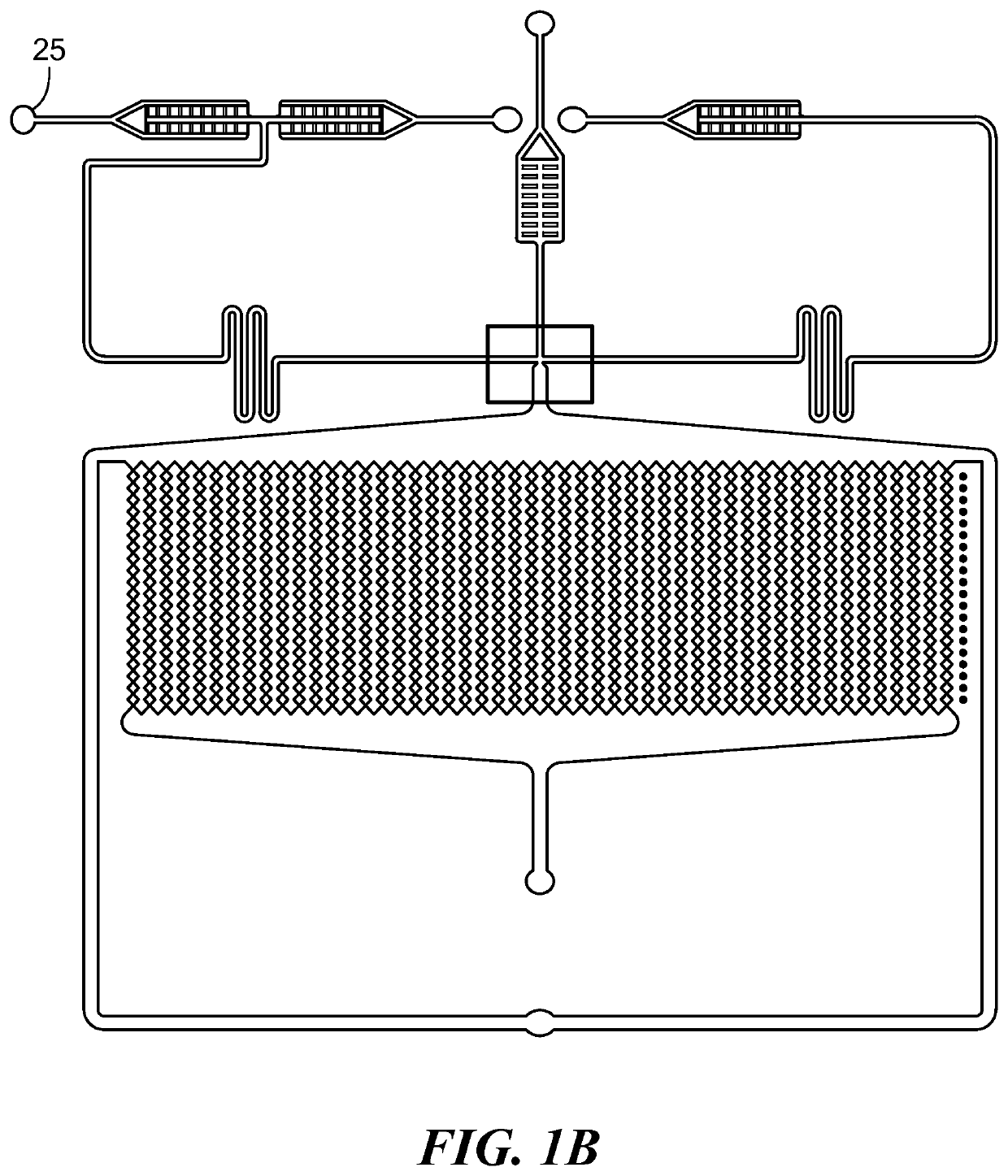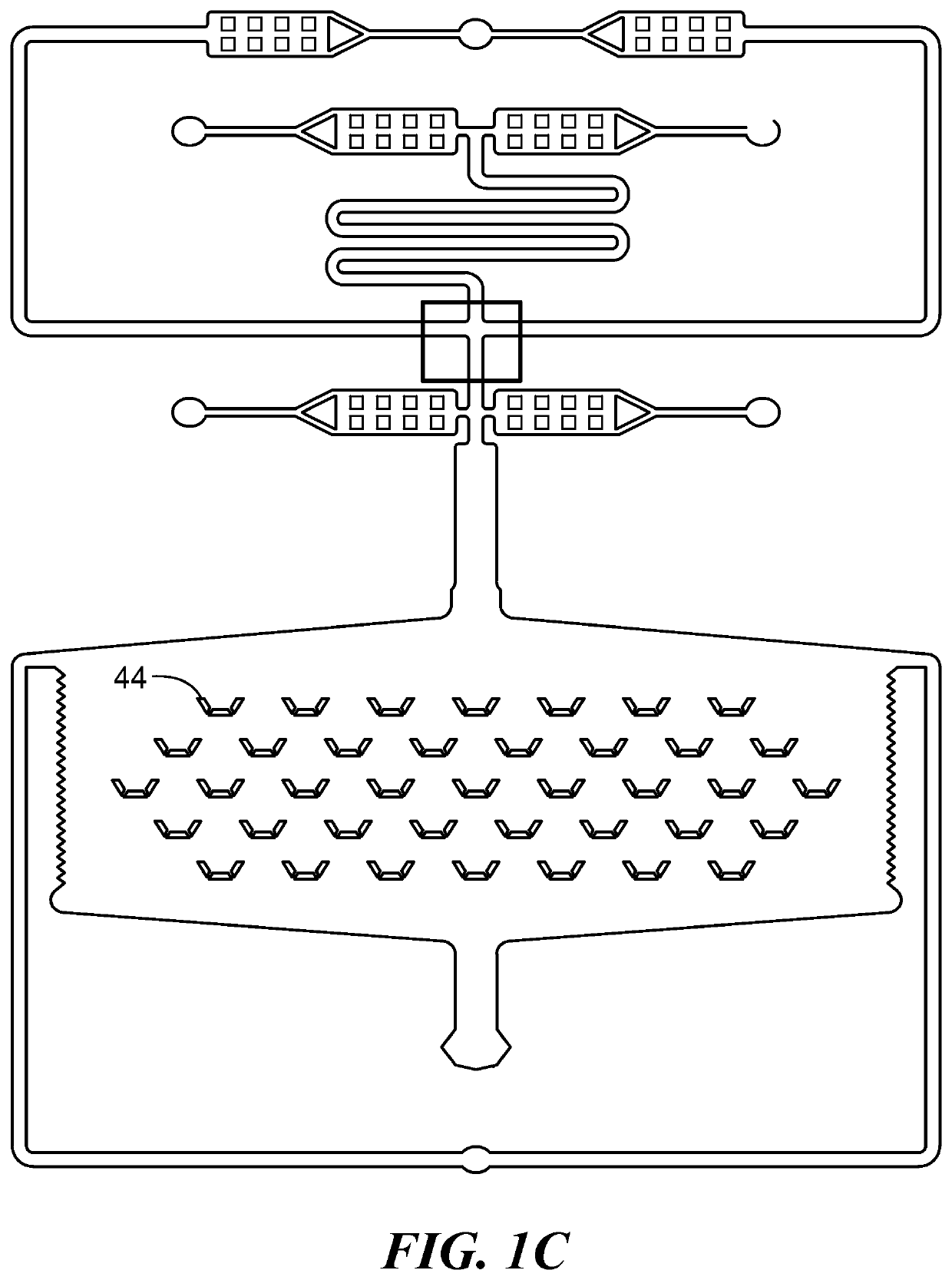Microfluidic device and method for analysis of tumor cell microenvironments
a microfluidic device and microenvironment technology, applied in the field of microfluidic devices and methods for analysis of tumor cell microenvironments, can solve the problems of inability to accurately represent tumor heterogeneity or resistance to drug penetration, current preclinical tools to investigate cancer biology and potential tumor treatments have significant problems, and can not achieve the effect of realistic drug response and high throughput generation
- Summary
- Abstract
- Description
- Claims
- Application Information
AI Technical Summary
Benefits of technology
Problems solved by technology
Method used
Image
Examples
example 1
Formation of Cell Spheroids in a Microfluidic Device
[0095]The microfluidic device depicted in FIG. 1A was used to prepare spheroids of MCF7 breast cancer cells. The three inlets of the device were simultaneously fed with mineral oil containing 3% v / v of Span 80 (a surfactant), a suspension of MCF7 cells at 7-10 million cells / mL and containing 2% w / v sodium alginate in Dulbecco's Modified Eagle Medium (DMEM) containing 10% v / v fetal bovine serum and 1% v / v antibiotic antimycotic solution, and a 4% w / v CaCl2 solution. The solutions were introduced simultaneously into the device using syringe pumps. The flow rates were 300 μL / hr for the oil, 75 μL / hr for the cell suspension, and 10 μL / hr for the calcium solution. The size of the microchambers was 200 microns, and the average size of the cell spheroids produced was 170+ / −25 microns. After the spheroids were produced, the flow of oil, cell suspension, and CaCl2 solution was stopped, the incubation chamber of the device was continuously p...
example 2
Cell Viability
[0096]The viability of cells in cell spheroids incubated in a microfluidics device of the invention was determined using the LIVE / DEAD viability / cytotoxicity assay for mammalian cells by Life Technologies (Cat No: L-3224). The kit included two dye components: calcein-AM as an indicator of live cells and ethidium homodimer-1 as an indicator of dead cells. For live cells, calcein-AM was cleaved by esterase enzymes to form the green fluorescent dye calcein in the cytoplasm of the cells. For dead cells, the compromised cell membranes allowed ethidium homodimer-1 to permeate and bind to the nucleic acids in the nuclei of the cells, which then emitted a red fluorescence.
[0097]3D spheroids of MCF7 adriamycin sensitive cells, a breast cancer cell line, were formed in a microfluidic device of the invention as described in Example 1. The cell spheroids were housed in the microfluidic device for 14 days and continuously perfused with fresh cell culture medium, and the cell viabil...
example 3
Sensitivity of Cell Spheroids to Antitumor Agents
[0098]The cell viability assay described in Example 2 was used to ascertain the sensitivity to doxorubicin of MCF7 breast cancer cells in cell spheroids present in a microfluidic device of the invention.
[0099]FIGS. 6A and 6B show adriamycin resistant MCF7 cell spheroids at 96 hr incubation without doxorubicin (FIG. 6A) and at 48 hr incubation with 12.8 μM doxorubicin (FIG. 6B). The red fluorescence in FIG. 6B indicates cell toxicity of the doxorubicin. FIGS. 6C and 6D show adriamycin sensitive MCF7 cell spheroids at 96 hr incubation without doxorubicin (FIG. 6C) and at 48 hr incubation with 12.8 μM doxorubicin (FIG. 6D). Comparing the red fluorescent nuclei staining in FIGS. 6B and 6D, it can be seen that adriamycin sensitive MCF7 cells were more susceptible to doxorubicin than the adriamycin resistant cells. FIGS. 6E and 6F show cell spheroids containing a mixture of adriamycin sensitive MCF7 cells and HS5 fibroblasts. FIG. 6E shows ...
PUM
| Property | Measurement | Unit |
|---|---|---|
| diameter | aaaaa | aaaaa |
| diameter | aaaaa | aaaaa |
| diameter | aaaaa | aaaaa |
Abstract
Description
Claims
Application Information
 Login to View More
Login to View More - R&D
- Intellectual Property
- Life Sciences
- Materials
- Tech Scout
- Unparalleled Data Quality
- Higher Quality Content
- 60% Fewer Hallucinations
Browse by: Latest US Patents, China's latest patents, Technical Efficacy Thesaurus, Application Domain, Technology Topic, Popular Technical Reports.
© 2025 PatSnap. All rights reserved.Legal|Privacy policy|Modern Slavery Act Transparency Statement|Sitemap|About US| Contact US: help@patsnap.com



